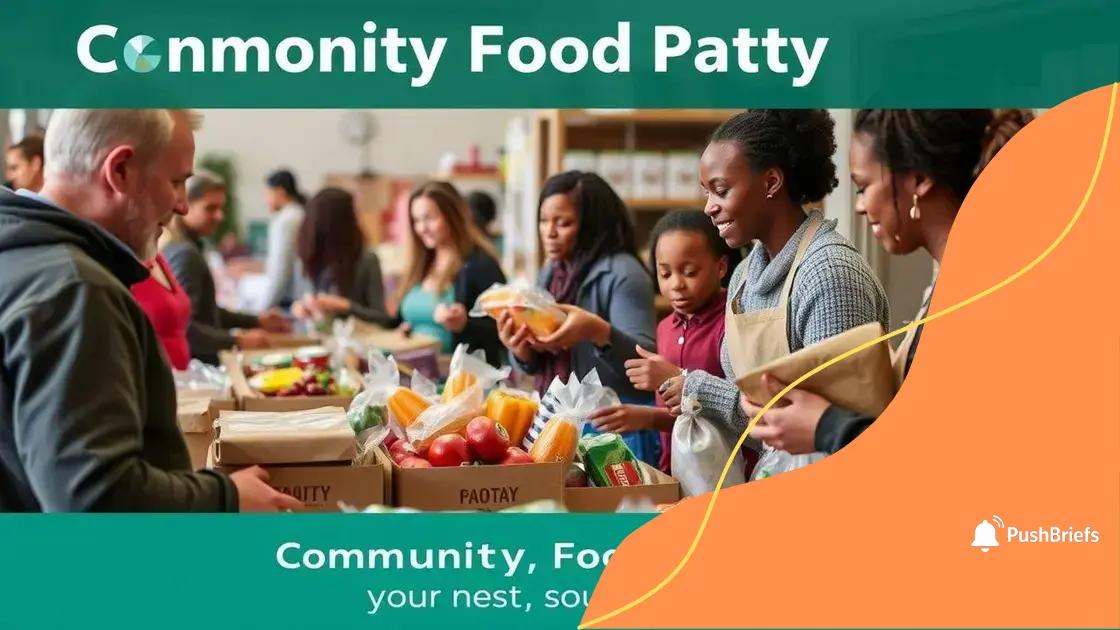Enrollment in food assistance programs remains high: what it means

Food assistance programs are essential initiatives that provide critical support and nutritional resources to individuals and families facing food insecurity, ensuring access to healthy food options.
Enrollment in food assistance programs remains high, reflecting the ongoing need in communities across the nation. Have you ever considered how these programs support families facing financial strain? Let’s dive into the impact they create.
Current statistics on food assistance enrollment
Understanding the current statistics on food assistance enrollment is vital for grasping the scope of assistance needed in communities. With more families relying on these programs, the numbers tell a significant story of need.
Enrollment Trends
As of recent reports, food assistance programs have seen a notable increase in participation. Some studies reveal that over 40 million people in the U.S. are currently enrolled in programs like the Supplemental Nutrition Assistance Program (SNAP). This represents a sharp rise compared to previous years.
Demographics of Enrollment
The demographics of those enrolling show that food assistance is critical for various groups. Here are some key points:
- Over 30% of participants are children, emphasizing the program’s role in supporting families.
- A significant portion of enrollees are seniors, who often face food insecurity on a fixed income.
- Many participants are from minority groups, highlighting disparities in food access.
Additionally, there are seasonal trends that impact enrollment, particularly during economic downturns or public health crises. For instance, during the pandemic, enrollments surged as many individuals faced sudden job losses and financial instability.
The Importance of Accurate Data
Tracking these statistics is crucial for policymakers and advocates. Accurate data helps in allocating resources effectively and designing programs that better meet the needs of these populations. Understanding who is using food assistance allows for targeted outreach and improved services.
Moreover, growth in enrollment numbers can influence legislative actions. Continuous monitoring of these statistics ensures that food assistance programs can adapt to changing needs, making them more effective in combating hunger across the country.
Challenges faced by applicants of food programs
Many individuals face significant challenges when applying for food assistance programs. These obstacles can discourage potential applicants from seeking the help they need, leaving them vulnerable.
Complex Application Processes
The application process for food assistance can often be confusing. Many applicants struggle to understand the requirements, which can vary from state to state. This complexity can lead to frustration and errors in filling out applications.
Stigma and Misunderstanding
Additionally, there is a stigma associated with receiving food assistance. Many people feel embarrassed or ashamed to ask for help, fearing judgment from others. This stigma can keep those in need from applying, even when they qualify.
Access to Information and Resources
Another challenge is limited access to information. Individuals may not know where to find resources or how to receive assistance. Even if they are aware of food programs, uncertain eligibility criteria may prevent them from seeking help. Here’s a look at some barriers:
- Limited outreach efforts in underserved communities.
- Lack of language support for non-English speakers.
- Transportation issues that hinder access to application sites.
For many, these challenges can feel overwhelming. People may encounter delays in getting their applications processed, which can worsen food insecurity. The frustration caused by long waiting periods often deters individuals from continuing their applications.
The role of food assistance in combating hunger

Food assistance programs play a crucial role in combating hunger across various communities. By providing essential resources, these initiatives help families access the nutrition they need to thrive.
Immediate Relief for Families
One of the most significant impacts of food assistance is its ability to offer immediate relief to families facing food insecurity. These programs ensure that individuals do not go hungry while they work to improve their financial situations. Many families rely on food assistance during tough economic times.
Support for Nutrition
Beyond just providing food, assistance programs aim to improve nutritional outcomes. They often include guidelines for healthy eating and resources for cooking nutritious meals. This focus on nutrition helps combat health issues related to poor diets, such as obesity and diabetes.
Creating Stability in Communities
Food assistance also plays a role in promoting economic stability. When families have access to food, they can allocate their limited resources to other essential needs, such as education and healthcare. This improvement in overall well-being contributes to stronger community bonds and better engagement in society.
Moreover, programs like SNAP inject funds into local economies. These funds help support local farmers and grocery stores, creating a cycle of economic growth within communities. Many studies highlight how food assistance strengthens local markets while providing necessary support to those in need.
Advocacy and Policy Changes
Food assistance advocates work tirelessly to ensure that these programs remain effective and available. They highlight the importance of sustaining funding and improving program accessibility. Ongoing advocacy is vital to adapt to changing needs and to challenge the stigma surrounding food assistance.
Innovations in food assistance programs
Innovations in food assistance programs have emerged as vital responses to the growing need for effective hunger relief. These advancements aim to enhance the efficiency and accessibility of support for families in need.
Technology Integration
One significant innovation is the integration of technology into food assistance initiatives. Many programs now utilize mobile apps and online platforms that allow for easier applications and access to benefits. These tools help streamline the application process and provide users with real-time updates on their benefits.
Community Partnerships
Another emerging trend is the establishment of partnerships between food assistance organizations and local businesses. By collaborating, these programs can create a smoother pathway for food distribution. Local grocery stores and farms often partner with food banks, allowing for direct supplies of fresh produce and other essential items.
- These partnerships often increase the variety of food available to recipients.
- They can help reduce food waste by redirecting surplus food to those in need.
- Community partnerships foster local involvement and support.
The focus on nutrition has also led to innovations aimed at delivering healthier food options. Some programs are now prioritizing access to nutritious foods rather than just staples. This emphasis helps combat diet-related illnesses in communities that rely on food assistance.
Outreach and Education Initiatives
Outreach efforts are being revamped to reach underserved populations more effectively. Many organizations are launching educational campaigns to inform potential applicants about their eligibility and the benefits available to them. By raising awareness, these campaigns aim to increase enrollment and ensure that more families receive the support they need.
Overall, these innovations signify a shift towards more responsive and inclusive food assistance programs, reflecting the changing needs of communities and the importance of effective strategies to combat hunger.
Future outlook for food assistance initiatives
The future outlook for food assistance initiatives appears promising yet challenging. As the needs of communities evolve, these programs must adapt to continue providing essential support.
Increased Funding and Resources
One trend shaping the future is the push for increased funding for food assistance programs. Advocates are calling for more government investment to ensure that programs can meet the growing demand. With more funds, these initiatives can expand their reach and improve the quality of the food provided.
Focus on Holistic Approaches
Another significant change is the shift toward holistic approaches that address not only food insecurity but also the underlying issues that cause it. Programs are beginning to incorporate services such as job training, financial education, and healthcare access. This comprehensive strategy aims to empower individuals and families, helping them achieve long-term stability.
- Creating community gardens to promote self-sufficiency.
- Partnering with local businesses for employment opportunities.
- Integrating mental health services into food programs.
Moreover, the increasing use of technology will play a crucial role in shaping the future of food assistance. Digital platforms that streamline applications and enhance communication between recipients and providers will likely become standard. This innovation will help make food assistance more accessible and efficient.
Emphasis on Nutrition and Health
As awareness of health issues related to diet grows, future initiatives will likely prioritize nutritional education and access to healthy foods. Many programs are already transitioning to providing more fresh produce and other nutritious options, recognizing that healthy eating can significantly impact overall well-being.
In summary, the future of food assistance initiatives will hinge on adaptability, community involvement, and the integration of support services that create a sustainable impact. By anticipating changes and addressing the root causes of hunger, these programs can better serve those in need.
FAQ – Frequently Asked Questions about Food Assistance Programs
What are food assistance programs?
Food assistance programs are initiatives designed to provide support to individuals and families facing food insecurity, ensuring they have access to nutritious food.
How can I apply for food assistance?
You can apply for food assistance through local agencies, government websites, or community organizations that offer resources and support for the application process.
What types of food are provided through these programs?
Food assistance programs typically provide a variety of food items, focusing on nutritious options such as fruits, vegetables, grains, and proteins to promote healthy eating.
Are there income requirements to qualify for food assistance?
Yes, most food assistance programs have income eligibility requirements. These thresholds ensure that assistance is directed to those with the greatest need.
